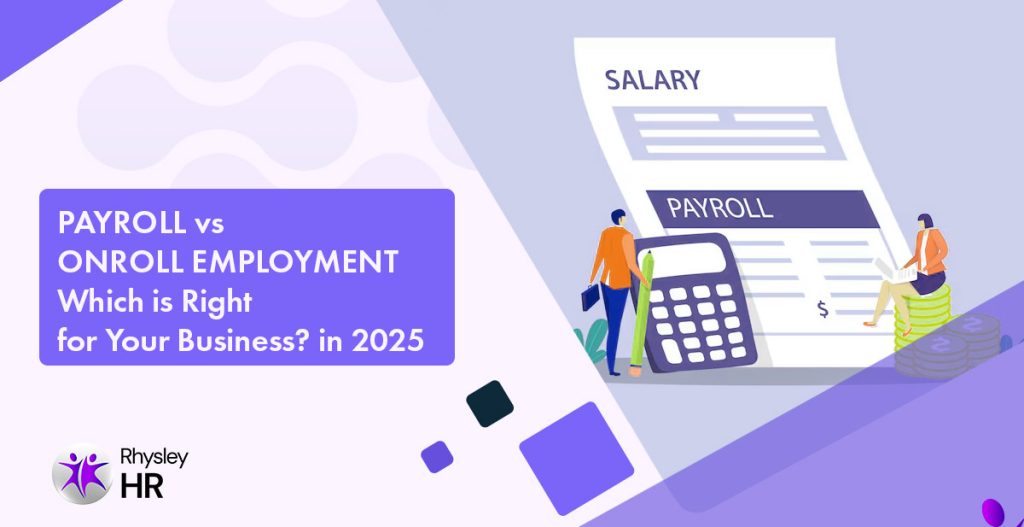Explore all premium features with a 1-Year Free Trial. Schedule your demo NOW!

Payroll Management vs Onroll Employment: Which Is Right for Your Business in 2025?
As we enter 2025, the business environment is increasingly dynamic, presenting organizations with fresh challenges and opportunities in managing their workforce. In this era of rapid change, understanding the nuances of payroll management and onroll employment is essential for any organization aiming for success.
Whether you’re launching a startup or steering a growing enterprise, knowing how to navigate these concepts can significantly impact your operational efficiency and employee satisfaction.
In this guide, we’ll unravel the definitions, distinctions, and advantages of payroll management and onroll employment, empowering you to make informed decisions that align with your business goals. Let’s explore what each entails and how they can shape the future of your workforce!
What Is Payroll Management?
It is the process of managing all financial aspects of employee payments, such as wages, tax deductions, bonuses, and other compensation records. With a strong payroll system, companies can pay their staff correctly and punctually, all while adhering to regulatory requirements.
Modern payroll software automates these tasks, saving time, reducing errors, and providing real-time insights into your company’s compensation strategy.
What Is Onroll Employment?
On-roll employment means the individual is directly employed and recognized as a formal staff member by the company. These employees receive regular salaries, benefits, insurance, bonuses, and are included in the company’s payroll system. They have a legal employment agreement and are eligible for perks such as paid leave, retirement plans, and medical coverage.
On the other hand, off-roll employees (often contractual or third-party hires) work for the company without being part of its formal payroll.
Why Payroll Software Matters for Onroll Employees
A robust payroll system plays a vital role in managing onroll employment. Here’s how:
Automated Salary Processing:
Reduces manual errors and ensures timely payment.
Tax Compliance:
Automatically Calculates deductions such as TDS, EPF, and ESI.
Employee Self-Service Portals:
Let employees check pay slips, tax statements, and leave balances.
Data Security:
Keeps sensitive payroll and personal data secure.
Scalability:
Easily adjusts as your business grows or your workforce expands.
Read More : How Does Payroll Software Work?
Onroll Benefits: Why Companies Prefer Onroll Over Off-Roll
There are several reasons why organizations prefer onroll employees over off-roll hires:
Loyalty and Retention:
Onroll employees are more committed and likely to stay long-term.
Better Skill Alignment:
Suitable for roles that need deep business understanding.
Compliance and Transparency:
Minimizes legal risks and improves organizational Integrity.
Full Control Over Work Quality:
Directly managing onroll employees leads to better outcomes.
When to Choose Off-Roll or Freelance Staff
While onroll employment is ideal for core roles, off-roll employees or freelancers can be a smart choice when:
- You need short-term or project-based work.
- You want to reduce long-term employment costs.
- You’re experimenting with new roles before making them permanent.
However, even off-roll staff can be managed using advanced payroll software that allows for flexible payment cycles and contract terms.
Choosing the Right Payroll System in 2025
With AI-powered automation and cloud-based tools becoming the norm, investing in modern payroll software is essential in 2025. Look for these features:
- Customizable payroll rules
- Integration with attendance and HR systems
- Real-time compliance updates
- Automated reporting and analytics
- Scalable architecture for remote teams
A smart payroll management tool ensures that both onroll and off-roll employees are paid on time, managed efficiently, and reported correctly.
Conclusion
Choosing between payroll vs onroll is not an either-or decision—it’s about finding the right mix for your business needs. Onroll employees are ideal for long-term roles, while a strong payroll management system ensures everyone gets paid correctly, whether they’re full-time, part-time, or freelance.
In 2025, the businesses that thrive will be those that combine smart hiring with smarter tools like advanced payroll software to keep things smooth, compliant, and efficient.
Frequently Asked Questions
How does on-roll employment differ from payroll?
Payroll is a process for managing salaries; onroll refers to full-time employees officially hired by a company.
Are all onroll employees managed through payroll?
Indeed, all on-roll employees are included in the company’s payroll system and receive consistent salaries and benefits.
Are off-roll employees included in a company’s payroll system?
Yes, off-roll employees can be paid via payroll software, though they aren’t entitled to the same benefits as onroll staff.
Why do companies choose onroll employees over off-roll?
Onroll employees offer better job commitment, higher retention, and are more aligned with company goals.
What are the benefits of using payroll software for onroll employees?
Payroll software ensures accuracy, saves time, supports compliance, and provides transparency for both HR and employees.